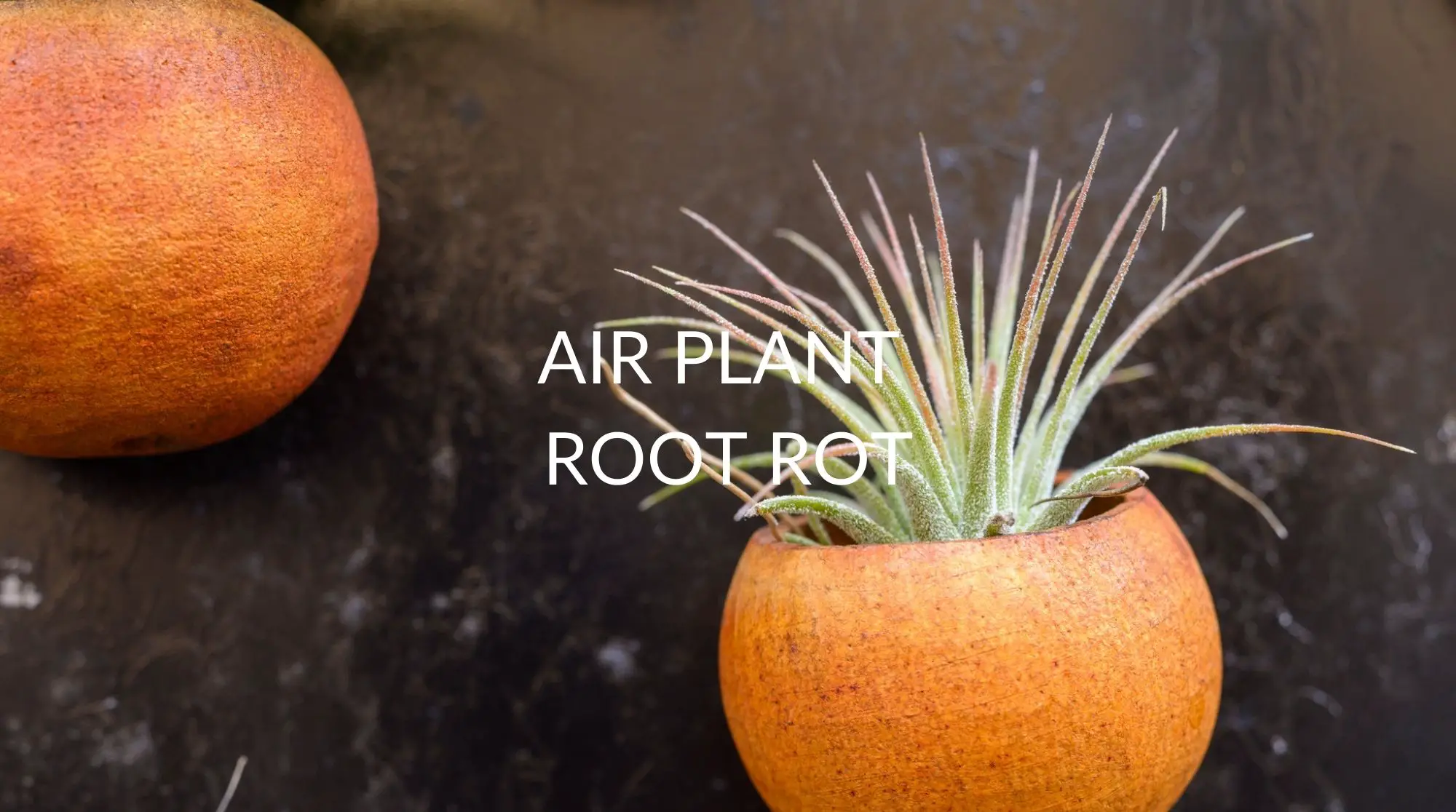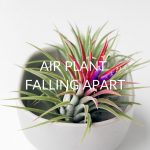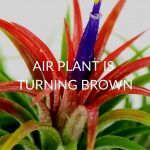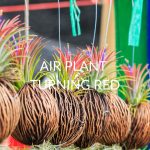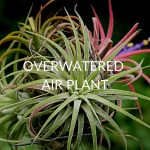There are a variety of reasons why air plants rot. Root rot in air plants is most commonly caused by overwatering. However, Dry rot will also grow if there isn’t enough air movement. Rotting can also be caused by insufficient sunlight and temperatures, inappropriate fertilizer application, or contaminants.
Continue reading to learn more about decaying air plants, root rot causes, warning indications, how to rescue a root-rot-infested air plant, and more.
Signs Of Root Rot on Your Air Plant
A black hue creeping up from the base of the plant into the leaves is the first sign of a decaying air plant. The air plant will also begin to come apart, the foliage will start to fall off, and the plant’s heart may fall out.
Internal or external rot can affect air plants. Externally, the plant is decaying if it develops brown or black damp patches on its leaves or the base darkens. If you don’t catch it early on, the rot will spread to the interior sections of the plant, causing it to fall apart.
If everything appears to be typical with your air plant until it succumbs to wear and tear one day, your air plant has succumbed to interior rot in this situation.
Air Plant Leaves Turning Soft or Mushy
Air plants aren’t supposed to be spongy or squishy. If one of these symptoms appears on your air plant, it might be suffering from rot.
Air Plant Leaves Turning Yellow
The leaves of an air plant that has succumbed to root rot begin to lose their vibrant color. If nothing is done, their green colors will fade and finally become colorless before dying.
Air Plant Leaves Falling Off
As root rot bacteria take over the base leaves of your air plant, they may discolor before falling off. If the base leaves of your air plant appear to be darkening, act quickly to remove the rot before the plant loses too many leaves or dies completely.
Here are other reasons why your Air plant is falling apart.
What Causes Air Plant Root Rot?
Can Overwatering Cause Root Rot in Air Plants?
The most common cause of rotting in air plants is overwatering. The effect of a fungal infection is rotting. Molds and yeasts are two types of fungus, but yeasts cause the yellowing of the leaves. The moss-covered surface becomes black and slimy and eventually decomposes.
Whatever method you use to water your air plant, shake it to remove any extra water before hanging it upside down or placing it on a towel to dry completely.
Can Incorrect Lighting Cause Root Rot in Air Plants?
All air plants require a significant quantity of indirect daily light to survive. Without correct lighting, an air plant may struggle to photosynthesize, leaving the moisture to collect in the plant, resulting in root rot.
The amount of light your air plant needs will depend on the species of plant it is. For example, unlike Mesic types, Xeric air plants can withstand only a few hours of direct sunshine. On the other hand, air plants cannot survive in dim light. If they’re left in dimly lit regions for too long, they’ll start to decay.
One should note that all air plants require at least six hours of indirect sunshine every day. They can be placed between 1–3 feet of windows facing east, west, or south. Install an artificial lighting system within 1–2 feet of the air plant if your residence doesn’t get enough light.
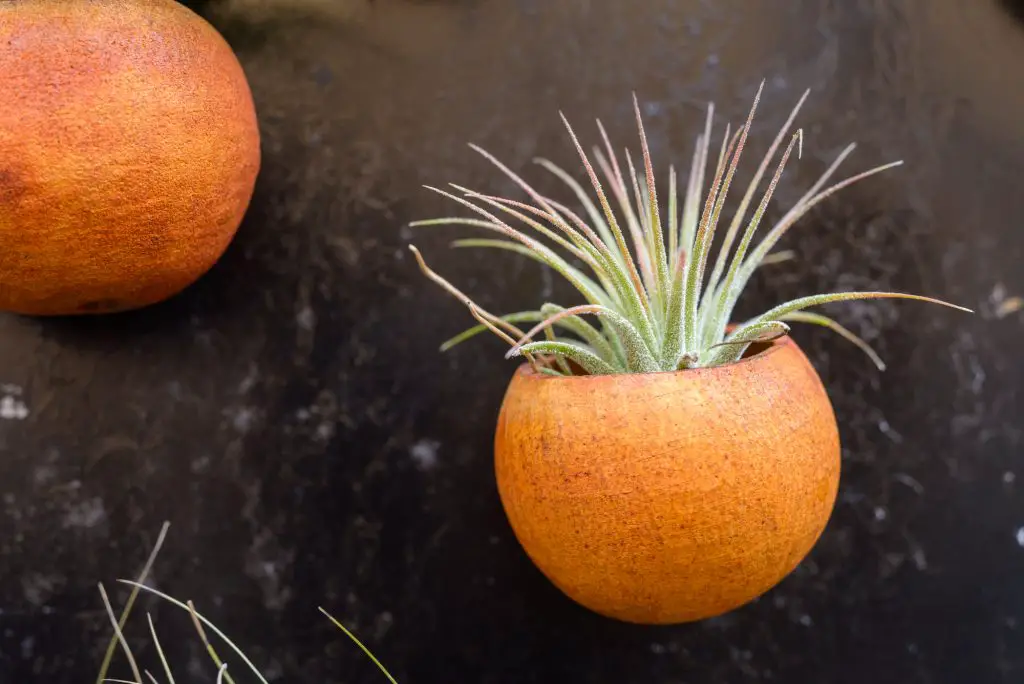
Can a Lack of Air Circulation Cause Root Rot in an Air Plant?
Dry rot is caused by insufficient air circulation and ventilation in air plants. Air plants will suffer from dry rot if there isn’t enough airflow to provide them with the nutrients they require from air particles.
This problem emerges when you install air plants in closed terrariums or containers. If you put the base of an air plant in a pot, box, or any other tight container with no ventilation, dry rotting will begin there and spread to other areas of the plant.
Can an Air Plant Develop Root Rot if Kept in an Improper Temperature?
Air plants exposed to incorrect temperatures and environments can be more prone to develop root rot.
Most air plants are native to warm climates, whether dry or wet. They can’t stand chilly temperatures, significantly below 40 degrees Fahrenheit. However, they will decompose if exposed to even the tiniest amount of frost. Although certain air plant species, such as Tillandsia usneoides, have adapted to flourish at cold temperatures, this is not true of all air plants.
The best temperature range for most air plants, especially commercial ones, is between 60- and 80-degrees Fahrenheit.
Other Causes of Air Plant Root Rot
Water, food, and the environment can all contain harmful compounds that promote rotting in air plants.
Copper and Root Rot in Air Plants
Copper is highly toxic to air plants. Look for any copper ornaments in their surroundings. While Copper is found in several types of pressure-treated wood, Copper might also be present in the wires you used to secure your plants in place.
If you notice any presence of Copper around your air plants, it is best to remove it immediately before it leads to complications like root rot. Take note that Copper can also be present in the fertilizer you’re using.
Smoke and Root Rot in Air Plants
Since air plants collect air molecules through their leaves, they may also absorb smoke particles, poisoning them and causing them to decay. Keep all sorts of smoke away from your air plants.
Water Salts and Root Rot in Air Plants
Sodium chloride replaces calcium and magnesium ions in most water softening systems. These salts aren’t hazardous to humans, but they can induce root rot in air plants. Air plants lack soil to filter out salts; They absorb them through their leaves. As a result, the salts will accumulate at the ends of the leaves, obstructing the pores’ ability to absorb nutrition.
Can You Save An Air Plant from Root Rot?
If your air plant’s root rot appears to only be affecting the outer leaves of your plant, it may still be saved. Remove the infected leaves and follow a strict watering and drying routine.
Air plants need to be misted or drenched in water to stay alive, although they don’t like to be wet. Once the plant has been watered or misted, it must dry. The fungus will take hold if the plant’s center remains moist, and the plant will therefore perish.
After you’ve finished watering your air plant, tilt it to enable the water to drain and let it dry for four hours. You may do this with a dish drainer or by turning the plant upside down on a dishtowel.
How To Treat Air Plant Root Rot
Catching the Rot Early
A root rot infection will be easier to treat if you discover it early. By paying close attention to your air plant’s watering schedule, light, air circulation, and fertilizer, you’ll ensure your plant remains happy and healthy. Always check the plant for symptoms of rotting while watering it.
Remove Any Dead Leaves by Trimming or Removing Them
Taking off any dead leaves from an air plant that has started to come apart is a natural and straightforward technique to keep it alive. Allowing your air plant to cling to diseased or dead leaves might obstruct airflow and sunlight absorption.
When dead leaves are removed, new ones sprout that are stronger. This is crucial because air plants get their nutrients and moisture from the atmosphere. You could realize that all that was necessary to bring the plant back to life was merely removing the dead leaves.
If tugging at the dead leaves causes the entire plant to fall apart, though, you’re in for some bad news. Your air plant may have already died if this happens. The secret to rejuvenating the plant is to look for green, healthy leaves. The air plant will undoubtedly have to be discarded if there aren’t any.
Using Cinnamon to Treat Root Rot in Air Plants
Cinnamon is a natural fungicide that may be used to inhibit the illness from spreading. Apply cinnamon powder on the afflicted areas after completing the preceding procedures and allowing the plant to dry. Carry on like this every day until the decaying is gone. Because the illness may return, dilute the water with cinnamon essential oil and use it to water the air plant.
How To Prevent Air Plant Root Rot?
Never Overwater an Air Plant
Maintain a regular watering schedule to avoid overwatering. Remember that, unlike many other house plants, Tillandsias absorb moisture through their leaves and trichomes rather than their roots and that they can be overwatered, causing root rot.
Never Allow an Air Plant to Soak in Water for More than a Few Hours
Never submerge an air plant in water for more than a few minutes. Some air plants should not be submerged in water, especially if you reside in a humid area. Also, never put your air plant back on display if it is moist; instead, wait until it is completely dry.
After Watering, Remove All Excess Moisture from Your Air Plant
After you’ve watered your air plant, shake off any excess water and allow it to dry completely before returning it to your terrarium, shell, or anywhere else you’ve placed it. Air plants should not be sprayed or allowed to sit in water in their terrariums.
What Does an Overwatered Air Plant Look Like?
Overwatering causes an air plant to become brown. You’ll notice that the plant’s base darkens and becomes sticky. Brown or black stains may appear on other parts of the leaves. Lower leaves will fall off one by one, allowing the plant’s center to appear. Yellowing leaves are typical, and the air plant as a whole will finally fall apart.
FAQ
What is the Best Way to Tell Whether My Air Plant Is Healthy?
If your air plant’s leaves are green and lush, it’s in good health. Sickness is indicated by dark bases, black dots, and brown leaf tips. Yellow, wrinkled, or curled toward the center leaves are not acceptable. You don’t need to be concerned if your adult air plant is blooming blooms because they only produce flowers when they’re in peak condition.
Is it True that Air Plants Merely Require Oxygen?
Sometimes known as “air plants,” Tillandsias requires more than simply air. Like any other houseplant, Air plants need water and light to grow. The ability to thrive without soil is what distinguishes air plants.
Display your air plant on a piece of driftwood or hang it with a macramé cord. There’s no need to contain your air plants or put them in soil. Bright, indirect natural light or fluorescent light can help your air plants grow. Air plants also need to be bathed for around 30 minutes once a week.
How Do You Soak Your Air Plant Without Causing Root Rot?
When you soak an air plant, make sure the entire plant is soaked in water. Trichomes are peculiar plant cells that coat the surface of air plants. These trichomes assist air plants in absorbing water via the plant’s surface. As a result, make sure to water the entire air plant rather than just the root region.
To avoid root rot, it’s usually best to soak for about 30 minutes at a time.
Recap
Air plant maintenance is simple, but it comes with its guidelines. If you don’t supply them with enough water, air, or light, they might develop diseases like any other plant.
One of the most frequent air plant illnesses is rot, which can be challenging to treat. Paying attention to these small parts of nature, on the other hand, can help you catch any illness early on, making it easier to treat. If your air plant shows indications of root rot, diagnose the problem as soon as possible, remove any dead or rotting leaves, and treat the infection with cinnamon.

